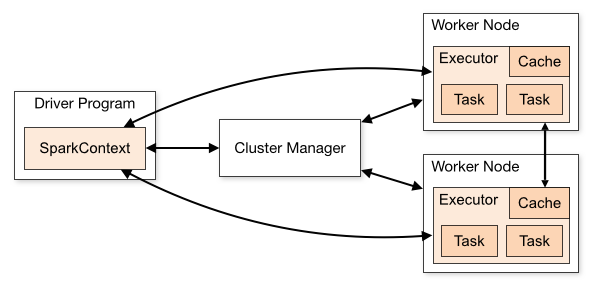https://spark.apache.org/docs/latest/cluster-overview.html
This document gives a short overview of how Spark runs on clusters, to make it easier to understand the components involved. Read through theapplication submission guide to submit applications to a cluster.
Components
Spark applications run as independent sets of processes on a cluster, coordinated by the SparkContext object in your main program (called thedriver program). Specifically, to run on a cluster, the SparkContext can connect to several types of cluster managers (either Spark’s own standalone cluster manager or Mesos/YARN), which allocate resources across applications. Once connected, Spark acquires executors on nodes in the cluster, which are processes that run computations and store data for your application. Next, it sends your application code (defined by JAR or Python files passed to SparkContext) to the executors. Finally, SparkContext sends tasks for the executors to run.

There are several useful things to note about this architecture:
- Each application gets its own executor processes, which stay up for the duration of the whole application and run tasks in multiple threads. This has the benefit of isolating applications from each other, on both the scheduling side (each driver schedules its own tasks) and executor side (tasks from different applications run in different JVMs). However, it also means that data cannot be shared across different Spark applications (instances of SparkContext) without writing it to an external storage system.
- Spark is agnostic to the underlying cluster manager. As long as it can acquire executor processes, and these communicate with each other, it is relatively easy to run it even on a cluster manager that also supports other applications (e.g. Mesos/YARN).
- The driver program must listen for and accept incoming connections from its executors throughout its lifetime (e.g., see spark.driver.port and spark.fileserver.port in the network config section). As such, the driver program must be network addressable from the worker nodes.
- Because the driver schedules tasks on the cluster, it should be run close to the worker nodes, preferably on the same local area network. If you’d like to send requests to the cluster remotely, it’s better to open an RPC to the driver and have it submit operations from nearby than to run a driver far away from the worker nodes.
Cluster Manager Types
The system currently supports three cluster managers:
- Standalone – a simple cluster manager included with Spark that makes it easy to set up a cluster.
- Apache Mesos – a general cluster manager that can also run Hadoop MapReduce and service applications.
- Hadoop YARN – the resource manager in Hadoop 2.
In addition, Spark’s EC2 launch scripts make it easy to launch a standalone cluster on Amazon EC2.
Submitting Applications
Applications can be submitted to a cluster of any type using the spark-submit script. The application submission guide describes how to do this.
Monitoring
Each driver program has a web UI, typically on port 4040, that displays information about running tasks, executors, and storage usage. Simply go to http://<driver-node>:4040 in a web browser to access this UI. The monitoring guide also describes other monitoring options.
Job Scheduling
Spark gives control over resource allocation both across applications (at the level of the cluster manager) and within applications (if multiple computations are happening on the same SparkContext). The job scheduling overview describes this in more detail.
Glossary
The following table summarizes terms you’ll see used to refer to cluster concepts:
| Term | Meaning |
|---|---|
| Application | User program built on Spark. Consists of a driver program and executors on the cluster. |
| Application jar | A jar containing the user's Spark application. In some cases users will want to create an "uber jar" containing their application along with its dependencies. The user's jar should never include Hadoop or Spark libraries, however, these will be added at runtime. |
| Driver program | The process running the main() function of the application and creating the SparkContext |
| Cluster manager | An external service for acquiring resources on the cluster (e.g. standalone manager, Mesos, YARN) |
| Deploy mode | Distinguishes where the driver process runs. In "cluster" mode, the framework launches the driver inside of the cluster. In "client" mode, the submitter launches the driver outside of the cluster. |
| Worker node | Any node that can run application code in the cluster |
| Executor | A process launched for an application on a worker node, that runs tasks and keeps data in memory or disk storage across them. Each application has its own executors. |
| Task | A unit of work that will be sent to one executor |
| Job | A parallel computation consisting of multiple tasks that gets spawned in response to a Spark action (e.g. save, collect); you'll see this term used in the driver's logs. |
| Stage | Each job gets divided into smaller sets of tasks called stages that depend on each other (similar to the map and reduce stages in MapReduce); you'll see this term used in the driver's logs. |





 本文提供了一段关于Spark如何在集群上运行的简洁概述,包括组件、使用指南、架构特性、集群管理类型、应用程序提交、监控、作业调度以及关键术语解释。重点突出了Spark在不同集群管理器上的通用性及应用程序在集群中的执行流程。
本文提供了一段关于Spark如何在集群上运行的简洁概述,包括组件、使用指南、架构特性、集群管理类型、应用程序提交、监控、作业调度以及关键术语解释。重点突出了Spark在不同集群管理器上的通用性及应用程序在集群中的执行流程。
















 1万+
1万+

 被折叠的 条评论
为什么被折叠?
被折叠的 条评论
为什么被折叠?








